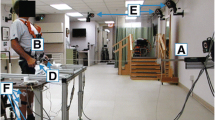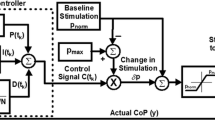Abstract
A control strategy is proposed to decrease quadriceps activity during standing. Modified on/off (or artificial reflex) control is used: a non-numerical or finite-state control scheme based on feedback of knee angle and angular velocity. The control strategy is evaluated in paraplegic patients in an experimental setup using transcutaneous stimulation. The stability of the system and its sensitivity to various control parameters are determined. It is concluded that the control scheme will enable reduction of muscle force independent of additional mechanical bracing or specific posture, and may result in continuous dynamic activation of muscle.
Similar content being viewed by others
References
Allin, J. andInbar, G. F. (1986) FNS control schemes for the upper limb.IEEE Trans.,BME-33, 818–828.
Andrews, B. J. et al. (1989) Rule-based control of a hybrid FES orthosis for assisting locomotion.Automedica,11, 175–199.
Bernotas, L. A., Crago, P. E. andChizeck, H. J. (1987) Adaptive control of electrically stimulated muscle.IEEE Trans.,BME-34, 140–147.
Crago, P. E., Mortimer, J. T. andPeckham, P. H. (1980) Closed loop control of muscle foice during electrical stimulation of muscle.,27, 306–311.
Crago, P. E. (1983) Control of movements by functional neuromuscular stimulation.Eng. in Med. & Biol. Mag.,1, 32–36.
Isakov, E., Mizrahi, J. andNajenson, T. (1986) Biomechanical and physiological evaluation of FES-activated paraplegic patients.J. Rehab. Res. & Dev.,23, 9–19.
Jaeger, R. J. (1986) Design and simulation of closed-loop electrical stimulation orthoses for restoration of quiet standing in paraplegia.J. Biomech.,19, 825–835.
Jaeger, R. J., Yarkony, G. M. andRoth, E. J. (1989) Rehabilitation technology for standing and walking after spinal cord injury.Am. J. Phys. Med. & Rehab.,68, 128–133.
Kralj, A., Bajd, T. andTurk, R. (1980) Electrical stimulation providing functional use of paraplegic patient muscles.Med. Progr. through Technol.,7, 3–9.
Kralj, A., Bajd, T., Turk, R. andBenko, M. (1986) Posture switching for prolonging functional electrical stimulation standing in paraplegic patients.Paraplegia,12, 221–230.
Marsolais, E. B., Bennett, G. andEdwards, C. C. T. (1988) Energy cost of walking and standing with functional neuromuscular stimulation and long leg braces.Arch. Phys. Med. & Rehab.,69, 243–249.
McClelland, M., Andrews, B. J., Patrick, J. H., Freeman, P. A. andMasri, W. S. (1987) Augmentation of the Oswestry parawalker aorthosis by means of surface electrical stimulation: gait analyses of three patients.Paraplegia,25, 32–38.
Merton, P. A. (1954) Voluntary strength and fatigue.J. Physiol.,123, 553–564.
Mortimer, J. T., Kerstein, M. D. andMagnusson, R. (1971) Muscle blood flow in the human biceps as a function of developed muscle force.Arch. Surg.,103, 376–377.
Mulder, A. J., Verheijen, J. M. E., Hermens, H. J. andVan Alste, J. A. (1987) Control of standing using functional electrical stimulation. InInt. Ser. on Biomech. XI-A.Groot, G. de Hollander, A. P., Huijing, P. A. andvan Ingen Schenau, G. J. (Eds.), Free University Press, Amsterdam, 208–213.
Mulder, A. J., Hermens, H. J., van Alsté, J. A. andZilvold, G. (1988) An improved strategy to minimize muscle fatigue during FES-induced standing. InElectrophysiological kinesiology.Wallinga, W., Boom, H. B. K. andde Vries, J. (Eds.), Exerpta Medica ICS 804, Elsevier, Amsterdam, New York, 109–112.
Mulder, A. J., Boom, H. B. K., Hermens, H. J. andZilvold, G. (1989) Artificial-reflex stimulation: clinical possibilities in paraplegic standing. Proc. Vienna 3rd Int. Conf. on FES, Baden/ Vienna, 47–50.
Peckham, P. H. (1987) Functional electrical stimulation: current status and future prospects of applications to the neuromuscular system in spinal cord injury.Paraplegia,25, 279–288.
Petrofsky, J. S. andPhillips, C. A. (1979) Constant-velocity contractions in skeletal muscle by sequential stimulation of muscle efferents.Med. & Biol. Eng. & Comput.,17, 583–592.
Petrofsky, J. S., Phillips, C. A. andStafford, D. E. (1984) Closed-loop control for restoration of movement in paralyzed muscle.Orthopedics,7, 1289–1302.
Petrofsky, J. S., Philips, C. A., Larson, L. andDouglas, R. (1985) Computer synthesized walking: an application of orthosis and functional electrical stimulation (FES).J. Neur. & Orth. Med. & Surg.,6, 219–230.
Rosman, N. andSpira, E. (1974) Paraplegic use of walking braces: survey.Arch. Phys. Med. & Rehab.,55, 310–314.
Solomonow, M. (1984a) Restoration of movement by electrical stimulation: a contemporary view of the basic problems.Orthopedics,7, 245–250.
Solomonow, M. (1984b) External control of the neuromuscular system.IEEE Trans.,BME-31, 752–763.
Stanic, U. andTrnkoczy, A. (1974) Closed-loop positioning of hemiplegic patient's joint by means of functional electrical stimulation.-21, 365–370.
Trnkoczy, A. (1974) Variability of electrically evoked muscle contractions with special regard to closed-loop controlled orthosis.Ann. Biomed. Eng.,2, 226–238.
Wilhere, G. F., Crago, P. E. andChizeck, H. J. (1985) Design and evaluation of a digital closed-loop controller for the regulation of muscle force by recruitment modulation.IEEE Trans.,BME-32, 668–676.
Author information
Authors and Affiliations
Rights and permissions
About this article
Cite this article
Mulder, A.J., Boom, H.B.K., Hermens, H.J. et al. Artificial-reflex stimulation for FES-induced standing with minimum quadriceps force. Med. Biol. Eng. Comput. 28, 483–488 (1990). https://doi.org/10.1007/BF02441972
Received:
Accepted:
Issue Date:
DOI: https://doi.org/10.1007/BF02441972




